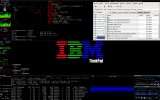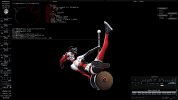I own a Lenovo ThinkPad P2000 "mobile workstation" (hexacore Intel Xeon E-2176M, nVidia Quadro P2000 Max-Q GPU, 32-GB ECC RAM, 1TB NVMe SSD).
Windows 10 is capable of using both the Intel integrated UHD P630 graphics as well as the dedicated nVidiaQuadro P2000 GPU. Not only can it switch between the two but it seems to be able to successfully use the integrated GPU for 2D tasks and only offloading heavy 3D stuff to the dedicated GPU.
I'm currently on a quest of making FreeBSD become my primary (and hopefully only) desktop OS. Windows 10 via bhyve seems to work well enough for the few use cases where I have to use Windows.
So far I managed to get two workstations "converted" from Windows 10 to FreeBSD 13.0 - all of which have either only intel integrated GPUs or only an nVidia dedicated GPU (always Quadro series).
What I'd like to know is how this particular dual-GPU scenario would play out in FreeBSD 13.0. I don't expect to be able to use both GPUs simultaneously like Windows 10 seems to be able to do with DirectX 12 but rather I'd already be satisified to turn off / disable the dedicated GPU when I don't need it (which is 90% of the time) and only firing up the dedicated Quadro GPU when I need it. It's even okay if this is a manual action (hopefully without rebooting tho). Is this possible in/with FreeBSD 13.0 and x11/nvidia-driver?
Could somebody share technical knowledge, experience and other information relevant for this?
Windows 10 is capable of using both the Intel integrated UHD P630 graphics as well as the dedicated nVidiaQuadro P2000 GPU. Not only can it switch between the two but it seems to be able to successfully use the integrated GPU for 2D tasks and only offloading heavy 3D stuff to the dedicated GPU.
I'm currently on a quest of making FreeBSD become my primary (and hopefully only) desktop OS. Windows 10 via bhyve seems to work well enough for the few use cases where I have to use Windows.
So far I managed to get two workstations "converted" from Windows 10 to FreeBSD 13.0 - all of which have either only intel integrated GPUs or only an nVidia dedicated GPU (always Quadro series).
What I'd like to know is how this particular dual-GPU scenario would play out in FreeBSD 13.0. I don't expect to be able to use both GPUs simultaneously like Windows 10 seems to be able to do with DirectX 12 but rather I'd already be satisified to turn off / disable the dedicated GPU when I don't need it (which is 90% of the time) and only firing up the dedicated Quadro GPU when I need it. It's even okay if this is a manual action (hopefully without rebooting tho). Is this possible in/with FreeBSD 13.0 and x11/nvidia-driver?
Could somebody share technical knowledge, experience and other information relevant for this?



